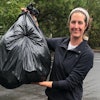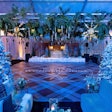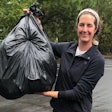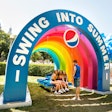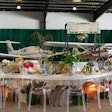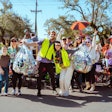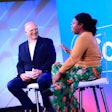Although not all companies are jumping in with both feet, many are producing green events on a one-time basis, to tie into the launch of an eco-related product or service, to promote an earth-friendly theme, or as a way to test a larger-scale green initiative. Here are 10.
1. For a 450-guest holiday party last December, Annika Dukes, marketing manager for Berkeley, California-based architecture firm Noll & Tam, brought Johanna Walsh of Twirl Management on board to give the annual blowout a greener spin. Guests were encouraged to take local commuter train service to the stop nearest Noll & Tam’s office, where shuttles ferried them the remaining two miles to the party. For many menu items, Walsh tracked down local and organic sources. To cut down on waste, she ordered locally brewed beer in kegs rather than individual bottles, and purchased all nonalcoholic drinks in bulk. Biodegradable plates and flatware as well as reusable china and glass tableware were used, and leftover food was either composted or donated.
2. A division of Boston-based Fidelity Investments brought RLC Events owner Jennifer Squeglia on board to help reduce the paper and waste at a monthly internal event for 100 senior managers. All presentations are now either downloaded to thumb drives or posted to the company’s Intranet for future access, and the company now reuses its name badges.
3. When the alumni of the Indian Institute of Technology met in Santa Clara, California, last July, even the banners that greeted the 1,000-member group were green, thanks to a joint effort by IIT operations and logistics co-chair Padma Chari and event production company Seven-Star. All signage was created on eco-friendly materials and printed with vegetable- and soy-based inks. The event featured other green elements, as well: Leftovers from the traditional Indian menu were partially composted (many red meats can’t be put into a composter), and china and linen were used instead of disposable tableware. Cups and napkins used for breaks were made of recycled paper, and were in turn recyclable themselves. Attendees also dropped waste into separate containers for trash, paper, and other recyclables. Even the bathrooms went green: Biodegradable soap and recyclable trash-can liners replaced their conventional counterparts.
4. The communications department of cosmetics company Aveda spearheaded a green initiative at New York’s Fashion Week in conjunction with labels Rodarte, 3.1 Phillip Lim, Rag and Bone, and Thakoon. Communications associate Ashley Bez handled the logistics, which included passing out more than 400 reusable aluminum bottles that could be refilled from jugs of New York tap water as a substitute for disposable water bottles. She worked with the clothing brands to ensure that their backstage catering was handled by City Bakery, which provided all organic or local food for staffers. Invitations and all other printed collateral were produced on recycled paper; Rodarte used old book covers.
5. In March Meredith Publishing kicked off a seven-month, 15-city eco-living tour in conjunction with Clorox, which was promoting the debut of its new line of green housecleaning products. For the Better Homes & Gardens Living Green Tour, Denise Basini, Meredith’s director of marketing and creative services, sourced recycled wood and aluminum to create the modular exhibit sets and made sure that all materials for the road show could be packed into a single biodiesel-powered truck. Consumer information was printed on recycled paper, and an on-site computer kiosk let guests access information about the show virtually rather in hard copy.
6. For the Food Bank for New York City’s 25th anniversary benefit dinner in April, the menu took on a new twist thanks to the efforts of Gregory Boroff, senior vice president of external relations, whose duties include orchestrating fund-raising events. Boroff greened the meal by featuring local, free-range and organic products, as well as vegan options. The event, held at Pier 60, was promoted via email invitations in order to cut down on paper. This was also the last year the Food Bank produced hard copies of its annual journal, which documents the Food Bank’s activities for donors. Beginning in 2009, Boroff and his team decided to take the journal online. In addition, the gift bags distributed were made from sustainably grown cotton canvas.
7. For a 2007 holiday party, Kimberly Finestone, owner of Beverly Hills-based Realty Consultant Group, hired Dana Morgan, owner of event production firm Green Carpet, to create an eco-friendly “winter wonderland” theme for RCG’s 200 employees, friends, and family members. Morgan collected branches from Runyon Canyon and spray-painted them white with low-VOC paint, then combined them with organic flowers. Finestone donated linens and lawn furniture she had in storage, which Morgan repurposed into an outdoor lounge, while bamboo torches and essential-oil votive candles provided light. Interior lights were refitted with CFL bulbs (and left in place after the event). The menu of hors d’oeuvres included organic chipotle chicken skewers and a steamed local vegetable platter, while libations included organic vodka and organic prosecco, both of which Morgan mixed with fresh fruits and juices to create specialty cocktails.
8. At the Women’s Conference last October, an event hosted by California governor Arnold Schwarzenegger and First Lady Maria Shriver, executive producer Julia Paige made several elements of the 14,000-guest conference green. All trash from the day’s zero-waste lunch was either composted or recycled, and recycling bins were placed next to garbage cans throughout the Long Beach Convention Center. The carbon generated by the conference was offset, as was attendees’ collective travel-related carbon footprint. All of the handouts participants received were printed on recycled paper, and conference totes were made from organic canvas.
9. For Earth Pledge’s FutureFashion show sponsored by Barneys New York in January, executive director Lesley Hoffman got 28 designers, including Marc Jacobs and Stella McCartney, to contribute green looks for the event’s catwalk—a runway made from timber destined for a furniture factory after the event. Invitations and other printed items were produced on recycled paper with soy ink. All of the backstage catering was done by City Bakery, which focuses on local and organic fare. V.I.P.s were ferried to the show via Lexus hybrid vehicles, and Earth Pledge conducted a post-show carbon footprint analysis to buy offsets.
10. To coincide with the launch of a corporate environmental policy in November, Jennifer Dela-Cruz, senior meeting planner for the Royal Bank of Canada, coordinated the implementation of several green elements into a Toronto conference for 350 senior bank managers. The bank bought carbon offsets for the 60 percent of attendees who flew in, and paid extra to ensure that the conference’s power came from wind (a service available through Ontario’s utility provider). Dela-Cruz replaced bottled water with pitchers and reusable glasses, and selected reusable tableware and cutlery for meals. She also had presentations uploaded to the conference Web site instead of distributing hard copies on-site.



